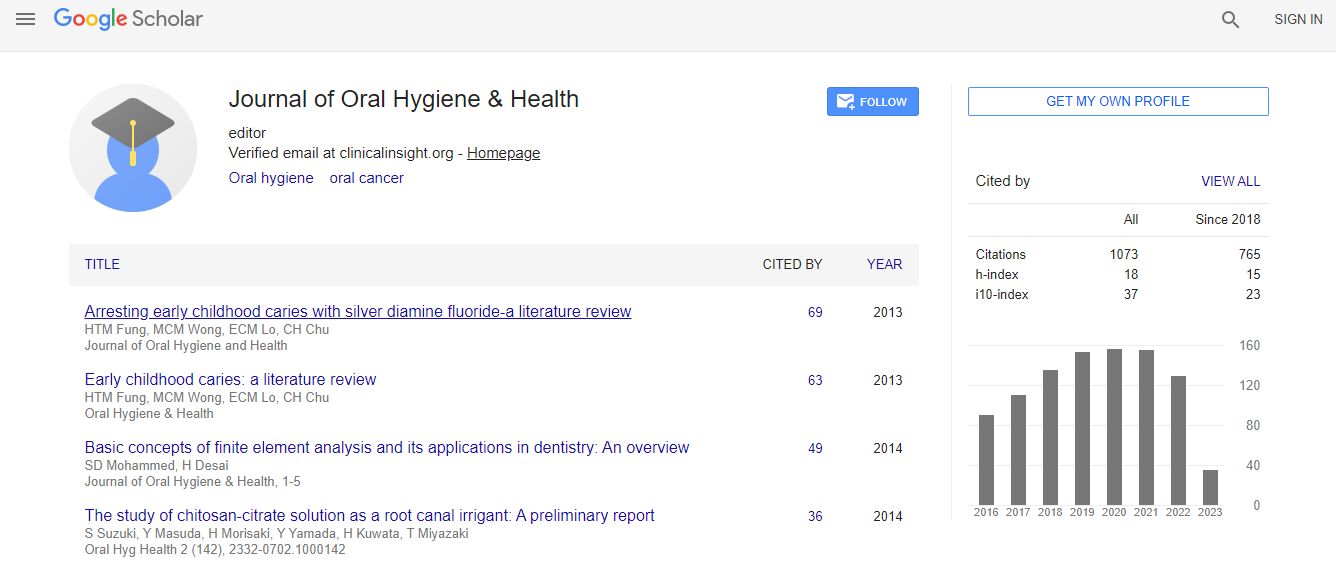Our Group organises 3000+ Global Conferenceseries Events every year across USA, Europe & Asia with support from 1000 more scientific Societies and Publishes 700+ Open Access Journals which contains over 50000 eminent personalities, reputed scientists as editorial board members.
Open Access Journals gaining more Readers and Citations
700 Journals and 15,000,000 Readers Each Journal is getting 25,000+ Readers
Google Scholar citation report
Citations : 1073
Journal of Oral Hygiene & Health received 1073 citations as per Google Scholar report
Journal of Oral Hygiene & Health peer review process verified at publons
Indexed In
- Index Copernicus
- Google Scholar
- Open J Gate
- JournalTOCs
- RefSeek
- Hamdard University
- EBSCO A-Z
- OCLC- WorldCat
- Publons
- Geneva Foundation for Medical Education and Research
- Euro Pub
- ICMJE
Useful Links
Recommended Journals
Related Subjects
Share This Page
Effect of dimethyl sulfoxide wet-bonding technique on hybrid layer quality and dentin bond strength
13th International Conference and Exhibition on Dental Medicine
Luis Roberto Marcondes Martins, Thiago Henrique Scarabello Stape, Cristiane Rumi Fujiwara Yanikian and Rodrigo Barros Esteves Lins
University of Campinas, Brazil
Posters & Accepted Abstracts: J Oral Hyg Health
Abstract
This study examined the effect of a dimethyl sulfoxide (DMSO) wet bonding technique on the resin infiltration depths at the bonded interface and dentin bond strength of different adhesive systems. Flat dentin surfaces of 48 human third molars were treated with 50% DMSO (experimental groups) or with distilled water (controls) before bonding using an etch-and-rinse (SBMP, 3M ESPE) or a self-etch (Clearfil: Clearfil SE Bond, Kuraray) adhesive system. The restored crown segments (n=12/group) were stored in distilled water (24 hours) and sectioned for interfacial analysis of exposed collagen using Massonâ��s Trichrome staining and for microtensile bond strength testing. The extent of exposed collagen was measured using Light Microscopy and a Histometric Analysis Software. Failure modes were examined by SEM. Data was analyzed by two-way ANOVA followed by Tukey Test (�±=0.05). The interaction of bonding protocol and adhesive system had significant effects on the extension of exposed collagen matrix (p<0.0001) and bond strength (p=0.0091). DMSO-wet bonding significantly reduced the extent of exposed collagen matrix for SBMP and Clearfil (p<0.05). Significant increase in dentin bond strength was observed on DMSO-treated specimens bonded with SBMP (p<0.05), while no differences were observed for Clearfil (p>0.05). DMSO-wet bonding was effective to improve the quality of resin-dentin bonds of the tested etch-and-rinse adhesives by reducing the extent of exposed collagen matrix at the base of the resin-dentin biopolymer. The improved penetration of adhesive monomers is reflected as an increase in the immediate bond strength when the DMSO-wet bonding technique is used with a water-based etch-and-rinse adhesive.Biography
Luis Roberto Marcondes Martins was graduated in Dentistry from the University of São Paulo in 1982. He did specialization in Restorative Dentistry in 1986 and Implantology in 1994. He has completed his Master’s degree in 1986 and PhD in 1991 in Restorative Dentistry from the University of São Paulo. He is currently a Professor at the State University of Campinas/FOP. He has more than 120 scientific papers published in scientific journals with numerous published in impact journals.
Email: martins@fop.unicamp.br

 Spanish
Spanish  Chinese
Chinese  Russian
Russian  German
German  French
French  Japanese
Japanese  Portuguese
Portuguese  Hindi
Hindi 
